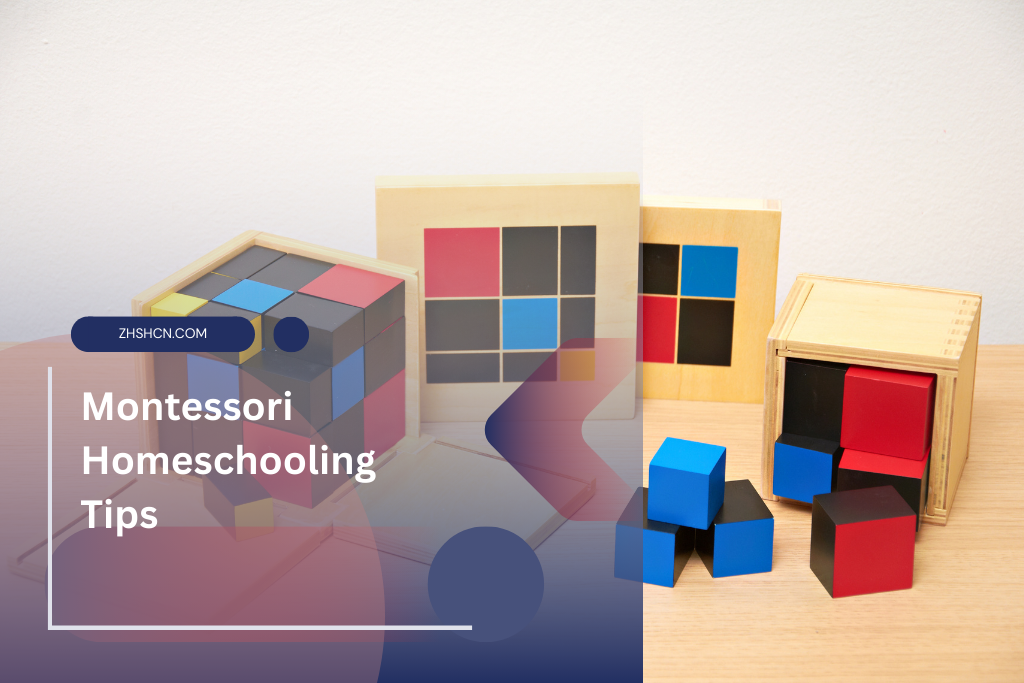Emphasizing independent learning, children in a Montessori system make creative choices for their learning while the classroom and teacher guide the process. As a result, children develop strong self-discipline, confidence, and a love for learning. When this method is adapted for a home setting, it’s often termed as Montessori homeschooling. Incorporating Montessori Homeschooling Tips can immensely benefit parents and guardians looking to embody the Montessori philosophy in a home education setting.
Key Takeaways
- Montessori homeschooling is a child-centered approach to education that emphasizes self-directed learning and collaborative play.
- Self-directed learning is the heart of the Montessori approach, allowing children to explore their interests and learn at their own pace.
- Montessori materials are specially designed learning tools that are multi-sensory, sequential, and self-correcting.
- The learning environment is also essential in Montessori homeschooling, and it should be designed to be stimulating, safe, and inviting.
- Structure and routine are important for Montessori homeschooling, but there should also be flexibility to allow for spontaneous learning.
Introduction
Montessori homeschooling is a child-centered approach to education that emphasizes self-directed learning and collaborative play. It is based on the principles of Dr. Maria Montessori, who believed that children learn best when they are free to explore their interests and learn at their own pace.
Montessori homeschooling is a great way to provide your child with a high-quality education in a supportive and nurturing environment. It is also a flexible option tailored to your child’s needs and learning style.
Montessori Homeschooling Tips: What is Montessori Homeschooling?
Montessori homeschooling is a method of education based on Dr. Maria Montessori’s principles. Montessori believed that children learn best when free to explore their interests and learn at their own pace. She also believed that children learn through all of their senses, not just through hearing and seeing.
Montessori classrooms are designed to be stimulating and safe for children to explore. They are filled with various Montessori materials specially designed learning tools that are multi-sensory, sequential, and self-correcting.
In a Montessori homeschool, the teacher acts as a guide and facilitator rather than a traditional instructor. The teacher’s role is to help children learn how to use the Montessori materials and to provide support and encouragement.

Montessori Homeschooling Tips: Benefits of Montessori Homeschooling
There are many benefits to Montessori homeschooling, including:
- Self-directed learning: Montessori homeschooling teaches children how to learn independently. This is a valuable skill that will benefit them throughout their lives.
- Love of learning: Montessori homeschooling fosters a lifelong love of learning in children. Children can explore their interests and learn at their own pace, which makes learning enjoyable and rewarding.
- Individualized learning: Montessori homeschooling can be tailored to each child’s individual needs and learning styles. This ensures that all children can reach their full potential.
- Social and emotional development: Montessori homeschooling allows children to develop social and emotional skills. Children learn to collaborate with others, resolve conflicts peacefully, and develop self-confidence.
Montessori Homeschooling Tips: How to Start Montessori Homeschooling
If you are interested in starting Montessori homeschooling, there are a few things you need to do to get started:
- Learn about the Montessori method: There are many resources available to help you learn about the Montessori method. You can read books, articles, and websites. You can also take online courses or workshops.
- Create a Montessori-friendly environment: Your child’s learning environment should be safe, inviting, and stimulating. You can create a Montessori-friendly environment by filling your home with Montessori materials and arranging them in a way that is accessible to your child.
- Provide your child with Montessori materials: Montessori materials are essential for Montessori homeschooling. You can purchase Montessori materials online or at specialty stores.
- Be patient and supportive: It takes time for children to adjust to the Montessori method. Be patient and supportive as your child learns to use the Montessori materials and develop independence.
Montessori Homeschooling Tips
Here are a few tips for Montessori homeschooling:
- Follow your child’s lead: The most important thing is to follow your child’s lead and allow them to learn at their own pace. Do not force your child to do something they are not interested in.
- Provide a variety of Montessori materials: Make sure to provide your child with a variety of Montessori materials to choose from. This will help to keep them engaged and motivated.
- Create a safe and inviting environment: Your child’s learning environment should be safe and inviting. This will help them to feel comfortable and relaxed.
- Be patient and supportive: It takes time for children to adjust to the Montessori method. Be patient and supportive as your child learns to use the Montessori materials and develop independence.
Montessori Homeschooling Tips: Creating an Inspiring Learning Environment
One of the paramount factors in delivering a productive Montessori education at home is creating an inspiring learning environment. It is the environment that first encounters the child and becomes a guiding tool for self-directed learning.
The key emphasis lies in creating a kid-friendly area and an environment that stimulates curiosity, explores creativity, and instills a lifelong love for learning. Therefore, designing a home Montessori is more than just organizing materials; it sets the stage for a child’s self-education.
Dr. Maria Montessori asserted, “Education is a natural process carried out by the child and is not acquired by listening to words but by experiences in the environment.”
Some vital elements for constructing an engaging Montessori learning environment at home encompass plenty of natural lighting, comfortable seating, quiet areas for concentration, and low shelves filled with various Montessori materials that are carefully selected per the child’s age, competence, and interest. Incorporating nature into the environment is also beneficial, as it nurtures the child’s innate love for the environment and encourages exploratory learning.
Creating an inspiring Montessori learning environment at home involves several key elements, such as adequate natural lighting to facilitate better visibility and evoke a welcoming aura. Comfortable seating is crucial to ensure the child’s ease and maintain focus over longer periods. Quiet areas are essential to enable concentration and uninterrupted learning experiences.
Selecting age-appropriate Montessori materials is equally important as they promote relevant and interest-based learning while aiding cognitive development at different stages of growth. Incorporation of nature into this environment fosters a love for the environment, encourages exploratory learning, instills respect for all living things, and enhances sensory skills by interacting with natural elements like plants or sand, etc.
Montessori Homeschooling Tips: Structuring Your Child’s Day for Optimal Learning
One of the fundamental steps in structuring your child’s day for optimal learning involves understanding and working with natural rhythms. Much like adults, children have periods of high energy and focus and times when they need rest and relaxation.
By identifying these prime times, parents can, thus, effectively schedule more challenging activities for when the child is most alert and receptive. For younger children, it’s crucial to incorporate frequent breaks for play and rest, maintaining a balance between academic tasks and leisure activities.
Regularity and predictability are key components in a child’s learning routine. A consistent daily routine can provide a sense of security and help children to manage their time well. However, flexibility should also be built within this routine to allow for spontaneous exploration and learning, fostering the child’s naturally inquisitive nature. While following these guidelines, it’s equally important to consider the uniqueness of each child and their individual learning styles and preferences.
– Scheduling activities according to child’s natural rhythms can enhance their receptivity and learning
– Balance between academic tasks and leisure activities is significant
– Regularity and consistency in the child’s routine bring about a sense of security
– There should be allowance for flexibility to promote spontaneous learning
– Understanding individual preferences and learning styles of the child is crucial manner
Montessori Homeschooling Tips: FAQ
What is a Montessori education?
A Montessori education is a teaching method designed by Dr. Maria Montessori, focusing on self-directed activity and collaborative play.
Can Montessori education be applied at home?
Yes, the Montessori education approach can be used effectively at home, giving your child room to explore their interests and learn at their own pace.
Should the routine be strictly adhered to?
While maintaining a consistent routine is important for a structure, leaving room for flexibility and spontaneous exploration is just as crucial.
What are Montessori materials?
Montessori materials are learning tools that are multi-sensory, sequential, and typically self-correcting, designed to help the child develop their senses and assist in understanding the world.
How do I identify my child’s natural rhythm?
Observe their daily patterns and note when they seem most alert, energetic, and focused and when they need rest or play.
Why is it important to create an inspiring learning environment at home?
An inspiring learning environment nurtures creativity, motivates children to learn, and supports their concentration and focus. An engaging, well-organized, and thoughtfully prepared environment also encourages independence and instills a love for learning.
How should I structure my child’s day for optimal learning?
You should set a routine incorporating focused learning periods, playtime, outdoor activities, and relaxation for optimal learning. It’s important to include breaks for meals and rest and to balance structured activities with free time for creativity and exploration.
How can I choose the right Montessori materials for homeschooling?
When choosing Montessori materials for homeschooling, consider your child’s age, interests, and developmental stage. Choose materials that are hands-on, engaging, and designed to promote independent learning. It’s also important to choose materials that align with the Montessori philosophy of fostering sensory learning and practical life skills.
Are there any specific Montessori materials that are recommended for various ages?
Yes, there are Montessori materials specifically designed for different age groups. For example, sensorial materials such as shape sorters, color tablets, and tactile balls are recommended for toddlers. For preschoolers, practical life materials like dressing frames, pouring materials, and language materials can be beneficial. For elementary aged children, advanced materials such as geometric solids, fraction materials, and language arts materials are recommended.
Can I make DIY Montessori materials at home?
Yes, you can create DIY Montessori materials at home. Homemade materials can be as effective as store-bought ones as long as they align with the Montessori philosophy. However, ensure they are safe and age-appropriate and promote hands-on learning, sensory exploration, and independent activity.

